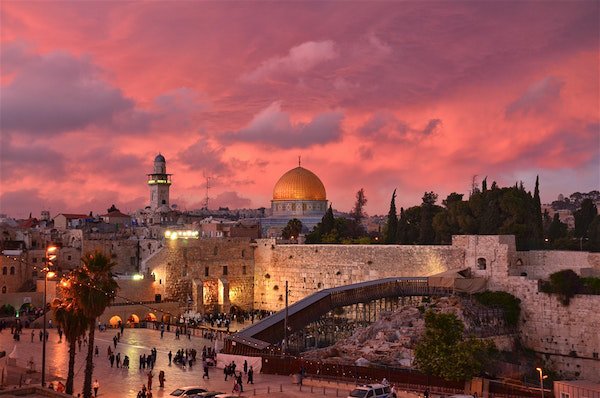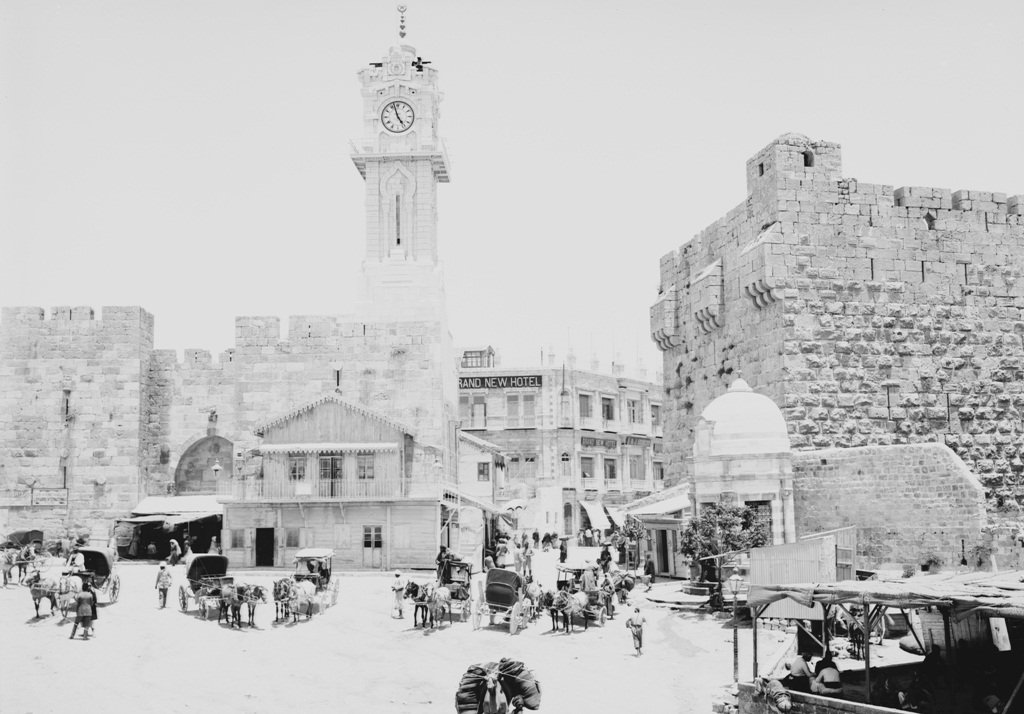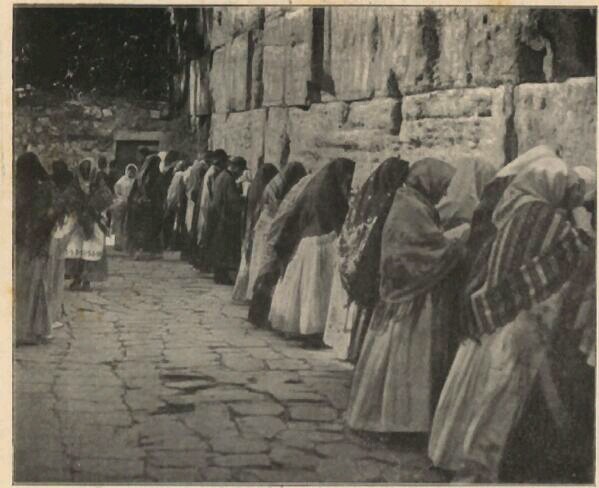
OH, JERUSALEM! OH, PALESTINE!
Today, Jerusalem holds distinct importance for followers of three major religions. Jerusalem, founded by the Prophet David (peace be upon him) some 3,000 years ago, is now known as East Jerusalem or the Old City. The Old City, covering an area of 6.5 square kilometers, presents the appearance of a medieval city with its stone buildings and winding narrow streets. It is divided into four quarters for Muslims, Christians, Armenians, and Jews, with unrestricted movement between them. The first three quarters are now mainly comprised of shops and places of worship, with small, old houses above the shops.
Jerusalem is built on four hills, and the Mount of Olives is one of them. In the heart of the Old City, on the rocky hill where it is said that the Prophet Abraham (peace be upon him) attempted to sacrifice his son, stands the Al-Aqsa Mosque. There is also Mount Zion, where the tomb of the Prophet David is said to be located.
To the west of the Old City, you'll find modern West Jerusalem or the New City, which was established during British and later Israeli rule. While Israel has declared this area as its capital and moved its parliament there, the international community does not recognize it as such and continues to maintain its embassies in the former capital, Tel Aviv.

Abode of Peace
When the Prophet David passed away in 973 BC, his son Solomon (peace be upon him) succeeded him and commissioned Phoenician architects to build the famous and magnificent temple known as the House of God, or Bet-ha Makdish, at the location prepared by his father. This temple is referred to as Al-Aqsa Mosque in the Quran. Prophet Solomon beautified Jerusalem, constructing numerous buildings, palaces, gardens, pools, and temples. It was the wealthiest and most beautiful city in the world. Its name back then was Urushalim (Jerusalem), meaning the Abode of Peace. Its former name was Zion.
Jerusalem also caused the first division among the Jews. A group of Jews opposed the establishment of Jerusalem and the Temple in what they saw as a departure from tradition. Their followers are known today as the Samaritans, and they reside in Nablus in present-day Palestine. In 587 BC, the Babylonian ruler Nebuchadnezzar destroyed and burned Jerusalem. He killed most of the Jews and exiled the rest to Babylon. During this upheaval, many copies of the Torah were lost.
After the Iranian ruler Cyrus defeated the Babylonians, he allowed the Jews to return in 539 BC. The Jews then repaired the Temple. After the invasion of Jerusalem by Alexander the Great in 332 BC, they lived under Macedonian rule and underwent significant Hellenization. Over time, Macedonian rulers banned Judaism, leading to Jewish rebellions. When these rebellions failed, the Jews sought help from the Romans. In 63 BC, Jerusalem fell into Roman hands. In 20 BC, the Roman-appointed Jewish governor of Palestine, Herod, rebuilt the Temple.
The Jewish Diaspora
Prophet Jesus (peace be upon him) lived in Jerusalem and ascended to the heavens from here. Hence, the city gained new significance. Traces of him are found all over the city. At the location where Christians believe he ascended to heaven, the Church of the Holy Sepulchre, built by Empress Helena, one of the first Christians, is one of the oldest churches in the world. Inside, there are places believed by Christians to be the tomb and burial site of Prophet Jesus.
The Jews rebelled against the Romans. However, in 70 AD, the Roman commander Titus completely destroyed Jerusalem, and the Temple was set ablaze. Only the western wall, known as the Wailing Wall, remained. Hadrian wanted to build a pagan temple in Jerusalem, which led to another Jewish revolt. After suppressing the rebellion, the Jews were forbidden from entering Jerusalem, and they dispersed throughout the world, leaving the region of Canaan, which is now known as Palestine.

Age of Peace
Prophet Muhammad (peace be upon him) experienced the Night Journey and Ascension (Isra and Miraj) from a stone that still exists in Jerusalem. He prayed in the partly ruined Al-Aqsa Mosque at that time, meeting with the spirits of previous prophets. The Quran mentions this miraculous event and characterizes Jerusalem as a blessed city.
During the time of Caliph Umar, Jerusalem, known as Iliya at that time, was peacefully conquered. Caliph Umar, upon arriving to receive the city's surrender, refrained from praying in the Church of the Holy Sepulchre, stating, "If I pray there, people may convert it into a mosque," and instead prayed nearby. In 1099, during the Fatimid rule, Jerusalem was seized and its population massacred by the Crusaders, leading to the establishment of the Kingdom of Jerusalem. However, in 1187, on the night of the Miraj, Salahuddin Ayyubi (Saladin) retook Jerusalem.
Muslims referred to the city as "Maqdis" or "Quddus," meaning a holy place. The first Qibla (direction of prayer) in Islam, Al-Aqsa Mosque, is also considered the third holiest place of worship by Muslims. The Umayyad Caliph Abd al-Malik built the Dome of the Rock, known for its glistening golden dome, over the stone from which Prophet Muhammad ascended during the Night Journey. This building remains a symbol of Jerusalem today. Adjacent to the Al-Aqsa Mosque and the Western Wall, Umayyad Caliph Walid ordered the construction of a mosque.
In 1516, Sultan Selim I conquered Jerusalem from the Mamluks. His son, Suleiman the Magnificent, fortified the city with walls and completed its development. He renovated the city, and a street in front of the walls and one of the city gates are named after him. Under Ottoman rule, Jerusalem became a period of peace and tranquility for people of all religions. The keys to significant religious sites were held by a corporal, ensuring that different religious groups could worship without conflicts.
Beneath the Western Wall, there are underground chambers where the old city of Jerusalem and the remnants of the temple's walls are found. Excavations have been conducted here since the Ottoman period, revealing the ancient city's remains beneath the western part of Jerusalem.
Jewish Homeland
After Jerusalem came under Muslim control, Jews were allowed to come here and worship, but they were not permitted to settle. The Young Turks, who came to power with Zionist support, opened Palestine to Jewish settlement and alienated the Arabs with their oppressive policies. On December 9, 1917, the Palestinian front collapsed. Mustafa Kemal Pasha, the commander of the Yıldırım Army Group, believed that individual peace was better than continuing the war. When he withdrew his army from Palestine and Syria, a 400-year Ottoman rule, which had started with a peaceful conquest in 1516, came to an end.
The Jewish influx into Palestine began. In 1917, in pursuit of financial support from Zionist advocate Lord Rothschild, and through the Balfour Declaration, Britain promised a homeland (not a state) to the Jews in Palestine. At the same time, Arabs under the leadership of Sheriff Hussein Pasha, who had risen against the Young Turk oppression, harbored the same dream. Under British mandate, where the New Jerusalem was founded, the Jewish population surpassed the Arabs.
In 1939, the British government admitted that the Balfour Declaration was a mistake. It's worth noting that the Palestinians did not get involved in the Arab revolt, nor did they sell land to the Jews. The Zionists purchased state land and land that some peasants had to sell due to an economic crisis. The refrain of "Traitor Arabs are getting what they deserve" should be abandoned. The Palestinian flag resembles other Arab flags determined during the struggle for independence. Green symbolizes Islam, black represents the Abbasids, red signifies Arabism, and white stands for independence.
.jpg)
Farewell, Jerusalem
In 1948, the state of Israel was established. Türkiye was one of the first countries to recognize it. Israel, in violation of a UN decision, declared West Jerusalem, which it had occupied and which covers 25 square kilometers, as its capital in 1950, and relocated its government offices, including the parliament, from Tel Aviv near the old Jaffa. Israel defeated the united Arab armies that attacked it in 1948, 1967, and 1973, tripling its territory. It took East Jerusalem and the West Bank from Jordan, Gaza from Egypt, and the Golan Heights from Syria. Due to the lack of international consensus, it cannot annex these territories.
Jerusalem holds great religious importance for both Christians and Muslims, more so than for Jews. The Golden Gate, located near the Al-Aqsa Mosque, is always kept closed. This is due to Christian beliefs that the Messiah will enter through this gate on the Day of Judgment. When the Messiah descends, this gate will miraculously open. Currently, the Al-Aqsa Mosque holds little significance for Jews, but they believe that the Messiah, whom they expect to arrive in the near future, will rebuild the temple. The site is under Muslim control today, and Jews are not allowed to enter.
Muslim places of worship in the occupied territories are administered by Jordan. Today, 30% of Israel's population is Palestinian. Among Jews, 30% strongly oppose Israel's expansionist policies, and they are known as the Ultra-Orthodox. There are also many pro-Palestinian civil societies among regular Jews who protest against the Zionist government (such as Peace Now, Ometz LeSarev, Gush Shalom, Sikkuy, Givat Haviva, Alternative Voice, School of the Heart, Ta'ayush, Bat Shalom, Fifth Mothers, etc.).
However, for the Zionists who hold the state, Jerusalem has symbolic significance. When on August 21, 1980, Israel declared Jerusalem, with its eastern and western parts, as its eternal capital, it sparked a strong reaction, even leading Türkiye to recall its ambassador. Later, this fait accompli was reluctantly accepted. At that time, 28% of the city's population was Arab. In 1947, when Israel was established, Britain had proposed that Jerusalem become an international open city. Today, the international community supports the idea of Jerusalem being the capital of both Israel and Palestine, divided between the two states.
Önceki Yazılar
-
FRIENDS OF ENGLAND ASSOCIATON24.04.2024
-
THE ASIA MINOR CATASTROPHE OF GREEKS17.04.2024
-
HOW DID WOMEN VEIL, AND THEN HOW WERE THEY UNVEILED…10.04.2024
-
HOW CAN HISTORY BE BELIEVED?3.04.2024
-
THE OFFICIAL MADHHAB OF THE OTTOMAN EMPIRE27.03.2024
-
WHO ORDERED THE PLUNDER OF ISTANBUL?20.03.2024
-
THE PLAYS BANNED BY SULTAN ABDULHAMID IN EUROPE13.03.2024
-
WHAT WAS THE MISTAKE OF THE UMAYYADS?6.03.2024
-
UNRAVELING THE UMAYYAD PERIOD: TRIUMPHS, TRAGEDIES, AND TRUTHS28.02.2024
-
OTTOMAN PENAL CODE AND HOMOSEXUALITY21.02.2024